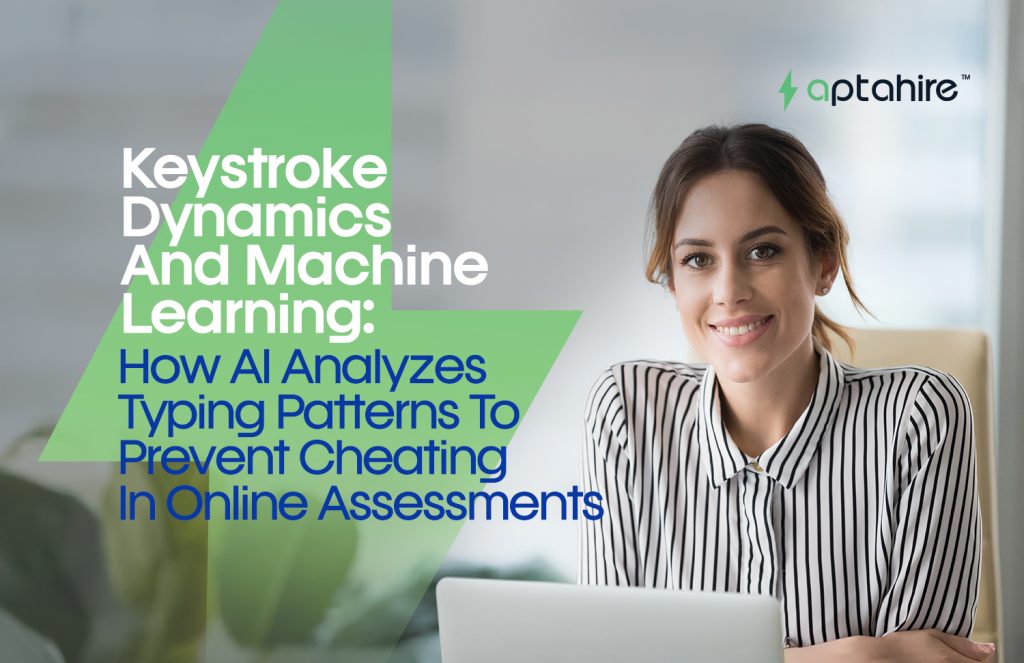Keystroke Dynamics and Machine Learning: How AI Analyzes Typing Patterns to Prevent Cheating in Online Assessments

In today’s increasingly remote-first world, the credibility of online assessments has become one of the most discussed challenges across education, corporate training, and remote hiring. We’ve all heard the question:
“How do you really know it’s the same person who’s answering the test from start to finish?”
It’s not just a hypothetical anymore. Cheating in online exams is real, rising, and increasingly difficult to catch with traditional surveillance. Fortunately, artificial intelligence (AI) is stepping in, not with a magnifying glass, but with something subtler and smarter: keystroke dynamics.
So, what is this futuristic-sounding technology? And how exactly does it catch a cheater just by analyzing how they type?
Let’s dive deep into it.
What is Keystroke Dynamics, Really?
Think of it this way: just like your fingerprint is unique to you, so is the way you type.
Keystroke dynamics is a behavioral biometric technique that captures and analyzes the timing, rhythm, and motion of how a person types on a keyboard. This includes things like:
- How long you hold down each key
- How quickly you move between keys
- How often you pause, backspace, or retype
- Your overall typing cadence and flow
This invisible “typing signature” is incredibly hard to fake. Even if someone knows your password or answers, they likely can’t imitate the exact rhythm and pattern with which you type.
Keystroke dynamics transforms everyday keyboard usage into a powerful tool for identity verification and fraud detection.
Why Is This Important in Online Exams?
In a physical exam hall, there’s invigilation, ID verification, peer pressure, and a controlled environment. But online? It’s just you, your screen, and potentially… a cheat sheet, a friend, or even a hired test-taker sitting off-camera.
This has led to some alarming trends:
- In a 2023 survey, 17% of students admitted to cheating in online assessments.
- In some remote proctored environments, AI caught up to 20–30% of suspicious behavior, ranging from looking away to using external devices.
- Companies have also reported higher than normal pass rates in technical hiring assessments, raising concerns about authenticity.
This is where keystroke dynamics becomes a game-changer. Instead of relying solely on visual surveillance (like webcam monitoring), it quietly observes the behavioral fingerprint of the user.
How Machine Learning Powers Keystroke Analysis
Let’s get into the real engine room: machine learning (ML).
Keystroke data alone isn’t enough. It needs intelligent interpretation. That’s where ML comes in. AI algorithms are trained to recognize, learn from, and flag deviations in typing patterns. Here’s a breakdown of how this works:
1. Baseline Typing Profile Creation
When a candidate takes their first test or logs into the system for the first time, the AI begins to observe:
- How they typically type
- Speed and hesitation points
- Natural typing rhythm
This is called the enrollment phase, where the system builds a reference profile unique to that individual.
2. Real-Time Monitoring
During assessments, the AI compares live typing data against the stored profile. It checks for:
- Sudden increase in typing speed
- Hesitations or unnatural pauses
- Different pressure patterns (if supported)
- Copy-paste behavior instead of manual typing
3. Anomaly Detection
If the typing pattern strays too far from the baseline, it triggers a flag. For example:
- Is someone else typing on their behalf?
- Did they start the test and hand it off mid-way?
- Are they copying from external material?
The AI doesn’t need to know what they typed, just how they typed it.
4. Adaptive Learning
Machine learning allows the system to evolve. Over time, as the user becomes more proficient or their typing changes slightly, the system adjusts the profile without compromising security.
What Kind of Data Is Captured?
To get technical, the AI tracks and analyzes dozens of parameters. Some of the most critical ones include:
| Metric | Description |
| Dwell Time | Duration for which a key is pressed down |
| Flight Time | Time between releasing one key and pressing the next |
| Typing Speed | Words per minute and consistency across sections |
| Error Rate | Frequency of corrections, backspaces, and retypes |
| Latency | Time taken to respond after seeing a question |
| Copy-Paste Detection | Unusually fast answer entry times |
| Rhythm Consistency | Repetition of signature patterns |
Combined, these give a deep behavioral insight that’s almost impossible to replicate intentionally.
Who’s Using Keystroke Dynamics Today?
It’s not just futuristic research labs anymore. Keystroke dynamics is already in use across sectors:
In Education
- Online universities like Coursera and edX integrate behavioral biometrics to prevent impersonation.
- Many LMS (Learning Management Systems) offer plugins that track typing patterns alongside proctoring.
In Hiring
- Remote-first companies are using it in technical hiring rounds, coding tests, and aptitude assessments.
- It helps prevent impersonation during pre-employment testing.
Corporate Training & Certifications
- L&D (Learning & Development) teams use it to verify the authenticity of in-house exams.
- Government certification bodies are beginning to explore keystroke biometrics to maintain test integrity in hybrid settings.
Is It Foolproof?
No technology is 100% infallible, but keystroke dynamics is remarkably effective as part of a multi-layered defense strategy.
When used alongside:
- Webcam proctoring
- Audio monitoring
- Browser lockdown
- Plagiarism detection
- Facial recognition
…it forms a comprehensive digital invigilation system that significantly reduces the risk of cheating.
A single keystroke deviation might not mean much, but consistent deviation across a session? That’s an alert.
Is It Ethical? What About Privacy?
That’s a valid concern, and one that system designers take seriously.
Here’s how keystroke monitoring can be implemented responsibly:
- No logging of actual keystroke content (what you type) — only behavioral metadata is captured.
- User consent and transparency — candidates should be informed and allowed to opt-in.
- Anonymized & encrypted storage — biometric data is stored as encrypted patterns, not raw input.
- Compliance with regulations like GDPR, CCPA, and local data laws.
It’s also far less intrusive than video monitoring, making it an ethical and discreet option when used right.
The Future of Digital Invigilation Is Behavioral
We’re moving beyond just watching people. Instead, we’re understanding how they behave, quietly and intelligently.
Keystroke dynamics is a prime example of this shift. It’s invisible, passive, non-invasive, and deeply tied to human behavior.
Imagine an AI that doesn’t just check if someone is looking at the screen, but knows if they’re typing like themselves. That’s the promise, and the power, of this technology.
Conclusion: Typing as Identity
In the end, your typing style is like a digital fingerprint. It speaks volumes without saying a word. And in the era of remote learning and virtual assessments, it’s becoming one of the most reliable ways to ensure integrity.
Whether you’re a university fighting academic dishonesty, a recruiter filtering out fake candidates, or a certification provider ensuring fairness, keystroke dynamics powered by AI can help.
It’s not science fiction anymore. It’s already here, typing quietly in the background, making sure the person on the keyboard is who they say they are.
FAQs
1. What is keystroke dynamics, and how does it work?
Keystroke dynamics is a type of behavioral biometric that analyzes how a person types, such as the timing between key presses, typing rhythm, and duration of keystrokes. These patterns are unique to each individual and can be used to verify identity or detect anomalies.
2. How does machine learning enhance keystroke dynamics analysis?
Machine learning algorithms are used to create, learn, and continuously refine a typing profile for each user. By comparing real-time keystroke data with previously learned patterns, the AI can identify unusual behavior that may suggest cheating or impersonation.
3. Can keystroke dynamics accurately detect identity fraud or cheating?
Yes. When trained on enough data, keystroke dynamics systems can detect identity anomalies with over 90% accuracy, especially when combined with other tools like facial recognition or webcam proctoring.
4. What kind of typing data does the AI analyze?
It analyzes several behavioral features, including:
- Dwell time (how long a key is pressed)
- Flight time (time between key releases and presses)
- Typing speed and rhythm
- Error patterns (like backspaces)
- Timing consistency
5. Is keystroke monitoring legal and ethical?
Yes, as long as it’s implemented with user consent, transparent data policies, and compliance with privacy laws like GDPR and CCPA. Most systems do not record what is typed, only how it’s typed.
6. Can typing patterns change over time or with different devices?
Yes, but machine learning accounts for natural variations and adapts to small changes over time. However, drastic shifts (like moving from a physical keyboard to a touchscreen) may require re-profiling.
7. In which industries is keystroke dynamics commonly used?
It is widely used in:
- Online education (to prevent academic dishonesty)
- Remote hiring (to ensure test authenticity)
- Cybersecurity (for continuous user authentication)
- Corporate training platforms (for certification integrity)
8. Can keystroke dynamics detect copy-paste behavior or external help?
Yes. AI can detect non-typed inputs (like pasted text) or unnatural typing spikes that deviate from the user’s normal behavior, helping flag suspicious activity during online assessments.



